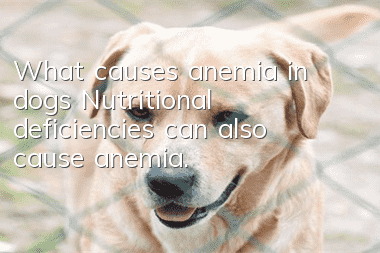What causes anemia in dogs? Nutritional deficiencies can also cause anemia.

Causes of dog anemia: hemorrhagic anemia
1. Acute hemorrhagic anemia is caused by rupture of internal organs (such as liver, spleen, vena artery and vena cava) and external blood vessels in dogs due to trauma or surgery. Massive bleeding causes the body's blood volume to suddenly decrease.2. Chronic hemorrhagic anemia is mainly caused by chronic stomach and intestinal inflammation, hemorrhagic inflammation of the lungs, kidneys, bladder and uterus, resulting in long-term repeated bleeding.
3. In addition, canine hookworm infection can also cause dogs to suffer from chronic hemorrhagic anemia.
Causes of anemia in dogs: Hemolytic anemia
Due to various reasons, anemia caused by a large amount of destruction of red blood cells in dogs is called hemolytic anemia.1. Caused by infectious factors. Such as leptospirosis, herpes pathogens, trypanosomiasis, hemolytic streptococcus infection, etc.
2. Toxic diseases. Heavy metal poisoning such as: lead, copper, arsenic, mercury, etc. Chemical drug poisoning: benzene, phenol, sulfa, etc. For example, police dogs inhaling TNT explosives while performing tasks can also cause hemolytic anemia.
3. Antigen-antibody reaction. Hemolytic anemia in newborn dogs is due to the different blood types of the newborn puppies and the blood types of the mother dogs. After the puppies eat breast milk, an antigen-antibody reaction occurs, causing hemolytic anemia in the puppies.
4. Other factors, such as febrile disease, lymphosarcoma, myelogenous leukemia, plasma hemoglobinemia, red blood cell pyruvate kinase deficiency and other factors can cause hemolytic anemia.
Causes of anemia in dogs: Nutritional anemia
Refers to the anemia that occurs when dogs lack certain hematopoietic substances, affecting the production of red blood cells and hemoglobin. This is nutritional anemia.1. Protein deficiency: caused by insufficient protein intake by animals or chronic digestive dysfunction.
2. Trace element deficiency: iron, copper, and cobalt deficiency. Clinically, iron deficiency anemia is common. Iron is an essential component for hemoglobin synthesis, and copper deficiency can also lead to reduced hemoglobin synthesis.
3. Vitamin deficiency: Deficiency of vitamin B1, vitamin B12, vitamin B6, folic acid, and glycolic acid will lead to disorders in the production of red blood cells and hemoglobin synthesis, resulting in nutritional anemia.
4. Most of the above factors are caused by dogs eating a single diet, chronic digestive tract diseases and intestinal parasitic diseases causing intestinal absorption dysfunction, leading to nutritional anemia over time.
Causes of anemia in dogs: aplastic anemia
Aplastic anemia refers to anemia caused by disorders of the bone marrow hematopoiesis function in dogs.1. Poisoning. Certain heavy metals, such as gold, arsenic, bismuth, etc.; certain organic compounds, such as benzene, phenol, trichlorethylene, etc.; certain excessive therapeutic drugs, such as chloramphenicol, sulfa drugs. Both can cause aplastic anemia.
2. Radiation damage. Exposure to large amounts of X-rays and certain radioactive elements can damage bone marrow cells, red blood cells, osteoid cells and megakaryocytes, causing these cells to suffer adverse effects.Reversible damage, leading to loss of hematopoietic function.
3. Certain diseases. For example: chronic kidney disease, leukemia, hematopoietic organ tumors, etc., can all lead to aplastic anemia.
Random articles
- Is it better for Dogo dogs to have their ears erect or cropped? A case of Dogo dog’s ear erection surgery will tell you
- What do dogs eat to protect their stomach? It is important to protect their stomach and treat gastrointestinal diseases in dogs.
- How to tell if your dog is fat? Is your dog overweight?
- Will your dog catch a cold if you blow the air conditioner? What should you do if your dog catches a cold if you blow the air conditioner?
- What should you pay attention to when your dog drinks water? Don’t be careless when it comes to your dog’s drinking water.
- The dog's mouth bites and shakes. Why does the dog's mouth occasionally shake and bite?
- How to cut a dog's hair? Do you know how to cut a dog's hair correctly?
- Can dogs eat raw eggs? Why can’t dogs eat egg whites?
- Common Dog Problems in Summer How to Deal with Different Dog Problems
- How to keep dogs away from skin diseases. If you do this, will you see if your dog will still be infected with skin diseases?



